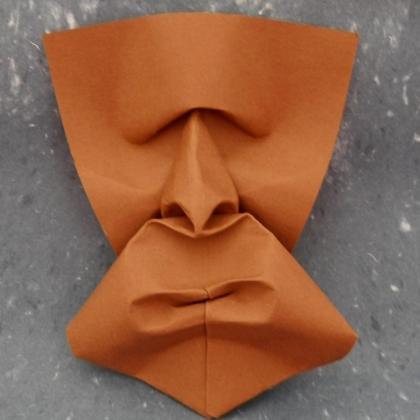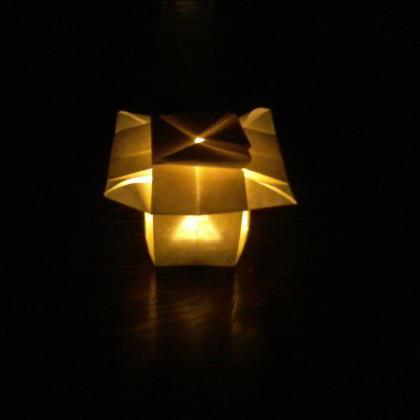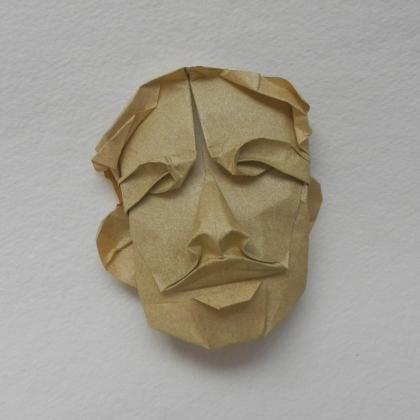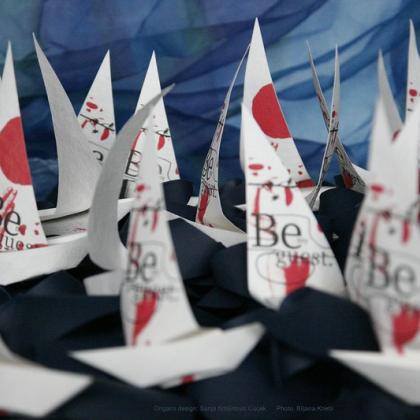Primary tabs
Creator
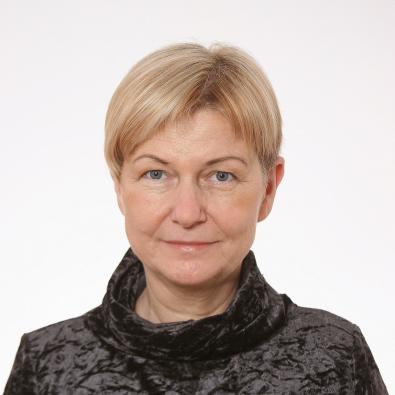
Sanja Srbljinović Čuček
Primary tabs
Croatian
English
German
Slovenian
Swedish
Mixed
Yes, you may use or teach any of my models for educational purposes only
Zagreb
Croatia
About Sanja
My origami enthusiasm began around 2005 when I realized origami was an art form and started searching for a master to learn from. Closest to my search were Masters of Origami in Salzburg. One day car trip to see the exhibition sealed a wish into my heart: Let's bring these masters home! And find out if we had any masters of the kind.
In 2007, when I joined BOS I was eagerly learning names of the world origami masters from the MIT Origami Mailing List for a reason. A city gallery was ready to open their doors to origami art. 50 kilometers north from my hometown Zagreb, town Krapina celebrated the 10th anniversary of a Croatian haiku festival. They asked me if I could exhibit those origami masters I was talking about all the time. I took the challenge. World renowned origami artists, David Brill, Goran Konjevod and Saadya Sternberg, decided to help with their contacts and works. And I got through to few local origami masters. So in June 2008 the first Croatian origami art exhibition with international origami masters, Poetry in Paper, welcomed its first visitors. Krapina City Gallery is now one of the rare museums that have origami artworks in their holdings.
Actually, the year of 2008 was my point of no return. I announced to my family that I was going to promote modern origami art full time, and they have been supporting me ever since. In a quest to show added values and visions of the new origami, creating own models was equally important as finding other origami enthusiasts and authors. Talking origami on every occasion somehow brought about my creating origami accessories for theatre sets in 2009.
The next year I was invited to run occasional origami workshops for the Japanese Embassy. That was crucial for our future origami society. At Japanese events you were more likely to meet another origami enthusiast or influence someone to become one. Soon after, first mini meetings popped up in cafés and bookshops. To share origami ideas, news and events, I started blogging on Origami Art Novosti. One of the first posts was English-Croatian origami dictionary. The blog was intended to inspire and serve as a signpost to a multitude of possibilities in the origami world. Since it has been visited by international audience, I started including English translations of some posts. In addition to my diagrammed models, origami musings and events, one can also find Croatian translations of origami themed English articles and translated subtitles of origami TEDx videos.
Little by little, origami got more respected. In 2011 our advertising agency Bruketa&Zinic&Grey chose my origami invitations for their client, Adris Cup. Invitations to run workshops at festivals and events multiplied, so when Croatian Origami Society (HOD) was founded in 2012, we already had a handful of yearly events by eminent educational and cultural institutions to participate in.
All that led to highly visited origami art exhibitions such as the one in Samobor in 2015, devoted to Croatian origami authors and the one in Rijeka in 2016, with international and Croatian origami masters, devoted to Rijeka's only origami teacher, promoter and origami author, Zdenka Šegota. Her dream, that her hometown sees the works of international origami masters, came true and Rijeka will remember and celebrate her as Origami Zdenka. Both exhibitions had over a thousand visitors in a few weeks.
Especially enjoyable was planting origami seeds among engineers and teachers, who make the most of our origami society. My modest collection of origami books grew by publishing origami diagrams in international model collections. Thus, whoever visited my origami studio, was able to get more informed on what modern origami was about. Discovering local origami authors and enthusiasts was another passion and to show their work in a gallery, another challenge of mine. Not to lose track of origami events having initiated or participated in, I stacked them as projects on my Linkedin profile. Since 2016 I have been regularly invited as an origami teacher at Tuna, Sushi & Wine Festival in Zadar. This led to my commissioned and donated origami works for the Archaeological Museum – they are now part of the Museum holdings.
I celebrate each time I am able to attend an origami conference and meet origami artists and enthusiasts. I have been attending Pecs origami conventions since 2010, participated at the 1st European Congress and origami conference in Spain 2013. My dream is to develop a team to run a Croatian convention with international guests.
More recent celebrations were when my origami was accepted for the NIA UK and EMOZ Zaragoza exhibitions and when I was invited to give origami themed lectures at Universities in Zagreb and Rijeka. One was on the importance of modern origami and its application in education, the other on origami as an educational toy of the new era.
In creating origami I often think about various people's needs and how origami can help them, how it can develop them, broaden their horizons. And in that effort I grow, too.
In 2007, when I joined BOS I was eagerly learning names of the world origami masters from the MIT Origami Mailing List for a reason. A city gallery was ready to open their doors to origami art. 50 kilometers north from my hometown Zagreb, town Krapina celebrated the 10th anniversary of a Croatian haiku festival. They asked me if I could exhibit those origami masters I was talking about all the time. I took the challenge. World renowned origami artists, David Brill, Goran Konjevod and Saadya Sternberg, decided to help with their contacts and works. And I got through to few local origami masters. So in June 2008 the first Croatian origami art exhibition with international origami masters, Poetry in Paper, welcomed its first visitors. Krapina City Gallery is now one of the rare museums that have origami artworks in their holdings.
Actually, the year of 2008 was my point of no return. I announced to my family that I was going to promote modern origami art full time, and they have been supporting me ever since. In a quest to show added values and visions of the new origami, creating own models was equally important as finding other origami enthusiasts and authors. Talking origami on every occasion somehow brought about my creating origami accessories for theatre sets in 2009.
The next year I was invited to run occasional origami workshops for the Japanese Embassy. That was crucial for our future origami society. At Japanese events you were more likely to meet another origami enthusiast or influence someone to become one. Soon after, first mini meetings popped up in cafés and bookshops. To share origami ideas, news and events, I started blogging on Origami Art Novosti. One of the first posts was English-Croatian origami dictionary. The blog was intended to inspire and serve as a signpost to a multitude of possibilities in the origami world. Since it has been visited by international audience, I started including English translations of some posts. In addition to my diagrammed models, origami musings and events, one can also find Croatian translations of origami themed English articles and translated subtitles of origami TEDx videos.
Little by little, origami got more respected. In 2011 our advertising agency Bruketa&Zinic&Grey chose my origami invitations for their client, Adris Cup. Invitations to run workshops at festivals and events multiplied, so when Croatian Origami Society (HOD) was founded in 2012, we already had a handful of yearly events by eminent educational and cultural institutions to participate in.
All that led to highly visited origami art exhibitions such as the one in Samobor in 2015, devoted to Croatian origami authors and the one in Rijeka in 2016, with international and Croatian origami masters, devoted to Rijeka's only origami teacher, promoter and origami author, Zdenka Šegota. Her dream, that her hometown sees the works of international origami masters, came true and Rijeka will remember and celebrate her as Origami Zdenka. Both exhibitions had over a thousand visitors in a few weeks.
Especially enjoyable was planting origami seeds among engineers and teachers, who make the most of our origami society. My modest collection of origami books grew by publishing origami diagrams in international model collections. Thus, whoever visited my origami studio, was able to get more informed on what modern origami was about. Discovering local origami authors and enthusiasts was another passion and to show their work in a gallery, another challenge of mine. Not to lose track of origami events having initiated or participated in, I stacked them as projects on my Linkedin profile. Since 2016 I have been regularly invited as an origami teacher at Tuna, Sushi & Wine Festival in Zadar. This led to my commissioned and donated origami works for the Archaeological Museum – they are now part of the Museum holdings.
I celebrate each time I am able to attend an origami conference and meet origami artists and enthusiasts. I have been attending Pecs origami conventions since 2010, participated at the 1st European Congress and origami conference in Spain 2013. My dream is to develop a team to run a Croatian convention with international guests.
More recent celebrations were when my origami was accepted for the NIA UK and EMOZ Zaragoza exhibitions and when I was invited to give origami themed lectures at Universities in Zagreb and Rijeka. One was on the importance of modern origami and its application in education, the other on origami as an educational toy of the new era.
In creating origami I often think about various people's needs and how origami can help them, how it can develop them, broaden their horizons. And in that effort I grow, too.
